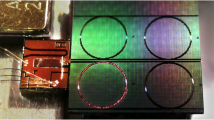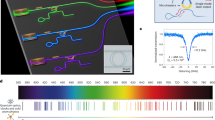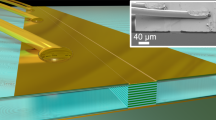Abstract
Driven by narrow-linewidth bench-top lasers, coherent optical systems spanning optical communications, metrology and sensing provide unrivalled performance. To transfer these capabilities from the laboratory to the real world, a key missing ingredient is a mass-produced integrated laser with superior coherence. Here, we bridge conventional semiconductor lasers and coherent optical systems using CMOS-foundry-fabricated microresonators with a high Q factor of over 260 million and finesse over 42,000. A five-orders-of-magnitude noise reduction in the pump laser is demonstrated, enabling a frequency noise of 0.2 Hz2 Hz−1 to be achieved in an electrically pumped integrated laser, with a corresponding short-term linewidth of 1.2 Hz. Moreover, the same configuration is shown to relieve the dispersion requirements for microcomb generation that have handicapped certain nonlinear platforms. The simultaneous realization of this high Q factor, highly coherent lasers and frequency combs using foundry-based technologies paves the way for volume manufacturing of a wide range of coherent optical systems.
This is a preview of subscription content, access via your institution
Access options
Access Nature and 54 other Nature Portfolio journals
Get Nature+, our best-value online-access subscription
$29.99 / 30 days
cancel any time
Subscribe to this journal
Receive 12 print issues and online access
$209.00 per year
only $17.42 per issue
Buy this article
- Purchase on Springer Link
- Instant access to full article PDF
Prices may be subject to local taxes which are calculated during checkout





Similar content being viewed by others
Data availability
All data generated or analysed during this study are available within the paper and its Supplementary Information. Further source data will be made available on reasonable request.
Code availability
The analysis codes will be made available on reasonable request.
Change history
06 April 2021
A Correction to this paper has been published: https://doi.org/10.1038/s41566-021-00805-y
References
Ludlow, A. D., Boyd, M. M., Ye, J., Peik, E. & Schmidt, P. O. Optical atomic clocks. Rev. Mod. Phys. 87, 637–701 (2015).
Newman, Z. L. et al. Architecture for the photonic integration of an optical atomic clock. Optica 6, 680–685 (2019).
Gundavarapu, S. et al. Sub-hertz fundamental linewidth photonic integrated brillouin laser. Nat. Photon. 13, 60–67 (2019).
Lai, Y.-H. et al. Earth rotation measured by a chip-scale ring laser gyroscope. Nat. Photon. 14, 345–349 (2020).
Trocha, P. et al. Ultrafast optical ranging using microresonator soliton frequency combs. Science 359, 887–891 (2018).
Suh, M.-G. & Vahala, K. J. Soliton microcomb range measurement. Science 359, 884–887 (2018).
Suh, M.-G., Yang, Q.-F., Yang, K. Y., Yi, X. & Vahala, K. J. Microresonator soliton dual-comb spectroscopy. Science 354, 600–603 (2016).
Spencer, D. T. et al. An optical-frequency synthesizer using integrated photonics. Nature 557, 81–85 (2018).
Li, J., Lee, H. & Vahala, K. J. Microwave synthesizer using an on-chip Brillouin oscillator. Nat. Commun. 4, 2097 (2013).
Liang, W. et al. High spectral purity Kerr frequency comb radio frequency photonic oscillator. Nat. Commun. 6, 7957 (2015).
Hao, T. et al. Toward monolithic integration of OEOs: from systems to chips. J. Lightwave Technol. 36, 4565–4582 (2018).
Marpaung, D., Yao, J. & Capmany, J. Integrated microwave photonics. Nat. Photon. 13, 80–90 (2019).
Liu, J. et al. Photonic microwave generation in the X- and K-band using integrated soliton microcombs.Nat. Photon 14, 486–491 (2020).
Kikuchi, K. Fundamentals of coherent optical fiber communications. J. Lightwave Technol. 34, 157–179 (2015).
Olsson, S. L. et al. Probabilistically shaped PDM 4096-QAM transmission over up to 200 km of fiber using standard intradyne detection. Opt. Express 26, 4522–4530 (2018).
Dahmani, B., Hollberg, L. & Drullinger, R. Frequency stabilization of semiconductor lasers by resonant optical feedback. Opt. Lett. 12, 876–878 (1987).
Hollberg, L. & Ohtsu, M. Modulatable narrow-linewidth semiconductor lasers. Appl. Phys. Lett. 53, 944–946 (1988).
Hemmerich, A., McIntyre, D., Schropp, D.Jr, Meschede, D. & Hänsch, T. Optically stabilized narrow linewidth semiconductor laser for high resolution spectroscopy. Opt. Commun. 75, 118–122 (1990).
Li, H. & Abraham, N. Analysis of the noise spectra of a laser diode with optical feedback from a high-finesse resonator. IEEE J. Quantum Electron. 25, 1782–1793 (1989).
Hjelme, D. R., Mickelson, A. R. & Beausoleil, R. G. Semiconductor laser stabilization by external optical feedback. IEEE J. Quantum Electron. 27, 352–372 (1991).
Liang, W. et al. Ultralow noise miniature external cavity semiconductor laser. Nat. Commun. 6, 7371 (2015).
Kondratiev, N. et al. Self-injection locking of a laser diode to a high-Q WGM microresonator. Opt. Express 25, 28167–28178 (2017).
Lee, H. et al. Chemically etched ultrahigh-Q wedge-resonator on a silicon chip. Nat. Photon. 6, 369–373 (2012).
Spencer, D. T., Bauters, J. F., Heck, M. J. & Bowers, J. E. Integrated waveguide coupled Si3N4 resonators in the ultrahigh-Q regime. Optica 1, 153–157 (2014).
Puckett, M. W. et al. Silicon nitride ring resonators with 0.123 dB/m loss and Q-factors of 216 million for nonlinear optical applications. In Proc. 2019 Conference on Lasers and Electro-Optics Europe & European Quantum Electronics Conference (CLEO/Europe-EQEC) ce_11_3 (OSA, 2019).
Ji, X. et al. Ultra-low-loss on-chip resonators with sub-milliwatt parametric oscillation threshold. Optica 4, 619–624 (2017).
Liu, J. et al. High-yield wafer-scale fabrication of ultralow-loss, dispersion-engineered silicon nitride photonic circuits. Preprint at https://arxiv.org/abs/2005.13949 (2020).
Ye, Z., Twayana, K., Andrekson, P. A. & Torres-Company, V. High-Q Si3N4 microresonators based on a subtractive processing for Kerr nonlinear optics. Opt. Express 27, 35719–35727 (2019).
Li, Q. et al. Vertical integration of high-Q silicon nitride microresonators into silicon-on-insulator platform. Opt. Express 21, 18236–18248 (2013).
Yang, K. Y. et al. Bridging ultrahigh-Q devices and photonic circuits. Nat. Photon. 12, 297–302 (2018).
Biberman, A., Shaw, M. J., Timurdogan, E., Wright, J. B. & Watts, M. R. Ultralow-loss silicon ring resonators. Opt. Lett. 37, 4236–4238 (2012).
Zhang, M., Wang, C., Cheng, R., Shams-Ansari, A. & Lončar, M. Monolithic ultra-high-Q lithium niobate microring resonator. Optica 4, 1536–1537 (2017).
Adar, R., Serbin, M. & Mizrahi, V. Less than 1 dB per meter propagation loss of silica waveguides measured using a ring resonator. J. Lightwave Technol. 12, 1369–1372 (1994).
Fan, Y. et al. Hybrid integrated InP-Si3N4 diode laser with a 40-Hz intrinsic linewidth. Opt. Express 28, 21713–21728 (2020).
Tran, M. A., Huang, D. & Bowers, J. E. Tutorial on narrow linewidth tunable semiconductor lasers using Si/III–V heterogeneous integration. APL Photonics 4, 111101 (2019).
Xiang, C. et al. Narrow-linewidth III–V/Si/Si3N4 laser using multilayer heterogeneous integration. Optica 7, 20–21 (2020).
Raja, A. S. et al. Electrically pumped photonic integrated soliton microcomb. Nat. Commun. 10, 680 (2019).
Shen, B. et al. Integrated turnkey soliton microcombs. Nature 582, 365–369 (2020).
Bauters, J. F. et al. Planar waveguides with less than 0.1 db/m propagation loss fabricated with wafer bonding. Opt. Express 19, 24090–24101 (2011).
Kippenberg, T. J., Spillane, S. M. & Vahala, K. J. Modal coupling in traveling-wave resonators. Opt. Lett. 27, 1669–1671 (2002).
Savchenkov, A., Williams, S. & Matsko, A. On stiffness of optical self-injection locking. Photonics 5, 43 (2018).
Wang, H., Wu, L., Yuan, Z. & Vahala, K. Towards milli-hertz laser frequency noise on a chip. Preprint at https://arxiv.org/abs/2010.09248 (2020).
Kondratiev, N. & Gorodetsky, M. Thermorefractive noise in whispering gallery mode microresonators: analytical results and numerical simulation. Phys. Lett. A 382, 2265–2268 (2018).
Huang, G. et al. Thermorefractive noise in silicon-nitride microresonators. Phys. Rev. A 99, 061801 (2019).
Lim, J. et al. Chasing the thermodynamical noise limit in whispering-gallery-mode resonators for ultrastable laser frequency stabilization. Nat. Commun. 8, 8 (2017).
Wang, P.-H. et al. Drop-port study of microresonator frequency combs: power transfer, spectra and time-domain characterization. Opt. Express 21, 22441–22452 (2013).
Vahala, K. J. Optical microcavities. Nature 424, 839–846 (2003).
Kippenberg, T. J., Gaeta, A. L., Lipson, M. & Gorodetsky, M. L. Dissipative Kerr solitons in optical microresonators. Science 361, aan8083 (2018).
Xue, X. et al. Mode-locked dark pulse Kerr combs in normal-dispersion microresonators. Nat. Photon. 9, 594–600 (2015).
Liang, W. et al. Generation of a coherent near-infrared Kerr frequency comb in a monolithic microresonator with normal GVD. Opt. Lett. 39, 2920–2923 (2014).
Lobanov, V., Lihachev, G., Kippenberg, T. & Gorodetsky, M. Frequency combs and platicons in optical microresonators with normal GVD. Opt. Express 23, 7713–7721 (2015).
Godey, C., Balakireva, I. V., Coillet, A. & Chembo, Y. K. Stability analysis of the spatiotemporal Lugiato–Lefever model for Kerr optical frequency combs in the anomalous and normal dispersion regimes. Phys. Rev. A 89, 063814 (2014).
Lihachev, G. V. et al. Laser self-injection locked frequency combs in a normal GVD integrated microresonator. In Proc. Conference on Lasers and Electro-Optics, OSA Technical Digest STh1O.3 (OSA, 2020).
Kondratiev, N. M. & Lobanov, V. E. Modulational instability and frequency combs in whispering-gallery-mode microresonators with backscattering. Phys. Rev. A 101, 013816 (2020).
Kondratiev, N. M., Voloshin, A. S., Lobanov, V. E. & Bilenko, I. A. Numerical modelling of WGM microresonator Kerr frequency combs in self-injection locking regime. In Proc. Nonlinear Optics and its Applications 2020, Vol. 11358, 113580O (International Society for Optics and Photonics, 2020).
Fülöp, A. et al. High-order coherent communications using mode-locked dark-pulse Kerr combs from microresonators. Nat. Commun. 9, 1598 (2018).
Stern, B., Ji, X., Okawachi, Y., Gaeta, A. L. & Lipson, M. Battery-operated integrated frequency comb generator. Nature 562, 401–405 (2018).
Larson, M. et al. Narrow linewidth sampled-grating distributed Bragg reflector laser with enhanced side-mode suppression. In Proc. 2015 Optical Fiber Communications Conference and Exhibition (OFC) 1–3 (IEEE, 2015).
Komljenovic, T. et al. Heterogeneous silicon photonic integrated circuits. J. Lightwave Technol. 34, 20–35 (2016).
Marin-Palomo, P. et al. Microresonator-based solitons for massively parallel coherent optical communications. Nature 546, 274–279 (2017).
Corcoran, B. et al. Ultra-dense optical data transmission over standard fibre with a single chip source. Nat. Commun. 11, 2568 (2020).
Tanzilli, S. et al. On the genesis and evolution of integrated quantum optics. Laser Photon. Rev. 6, 115–143 (2012).
Lee, H. et al. Spiral resonators for on-chip laser frequency stabilization. Nat. Commun. 4, 2468 (2013).
Puckett, M. W. et al. 422 million Q planar integrated all-waveguide resonator with a 3.4 billion absorption-limited Q and sub-MHz linewidth. Preprint at https://arxiv.org/abs/2009.07428 (2020).
Acknowledgements
We acknowledge support from the Defense Advanced Research Projects Agency (DARPA) under the DODOS (HR0011-15-C-055) and APHI (FA9453-19-C-0029) programmes and Anello Photonics.
Author information
Authors and Affiliations
Contributions
The experiments were conceived by W.J., Q.-F.Y., L.C., B.S. and H.W. The devices were designed by W.J. and A.F. Measurements were performed by W.J., Q.-F.Y., L.C., B.S. and H.W., with assistance from M.A.L., L.W. and M.G. Analysis of the results was conducted by W.J., Q.-F.Y. and H.W. The project was coordinated by Q.-F.Y. and L.C. under the supervision of J.E.B., K.J.V. and M.P. All authors participated in writing the manuscript.
Corresponding authors
Ethics declarations
Competing interests
The authors declare no competing interests.
Additional information
Peer review information Nature Photonics thanks Andrey Matsko, Michael Watts and the other, anonymous, reviewer(s) for their contribution to the peer review of this work.
Publisher’s note Springer Nature remains neutral with regard to jurisdictional claims in published maps and institutional affiliations.
Supplementary information
Supplementary Information
Supplementary Figs. 1–6 and Discussion.
Rights and permissions
About this article
Cite this article
Jin, W., Yang, QF., Chang, L. et al. Hertz-linewidth semiconductor lasers using CMOS-ready ultra-high-Q microresonators. Nat. Photonics 15, 346–353 (2021). https://doi.org/10.1038/s41566-021-00761-7
Received:
Accepted:
Published:
Issue Date:
DOI: https://doi.org/10.1038/s41566-021-00761-7
This article is cited by
-
Strong interactions between solitons and background light in Brillouin-Kerr microcombs
Nature Communications (2024)
-
Integrated optical frequency division for microwave and mmWave generation
Nature (2024)
-
Highly-coherent second-harmonic generation in a chip-scale source
Light: Science & Applications (2024)
-
Synthetic reflection self-injection-locked microcombs
Nature Photonics (2024)
-
Integrated vortex soliton microcombs
Nature Photonics (2024)



